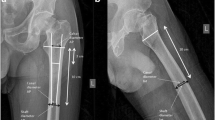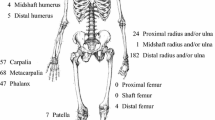Abstract
Objective
To examine the association between rachitic changes and vitamin D levels in children less than 2 years old with fractures.
Methods
Children less than 2 years old who were admitted to a large children’s hospital for a fracture and underwent a skeletal survey were included. Two pediatric radiologists blinded to the children’s vitamin D levels independently reviewed the skeletal surveys for the following rachitic findings: demineralization, widened sutures, rachitic rosary, Looser zones, and metaphyseal changes. Kappa coefficients were calculated to assess inter-rater agreement. Logistic regression was used to test the association between vitamin D level and rachitic findings.
Results
There were 79 subjects (40 female and 39 male) with a median age of 4 months. Vitamin D levels ranged from 11.6 to 88.9 ng/ml and were low in 27. Questionable demineralization was noted in seven subjects; mild to moderate demineralization was observed in four subjects. Widened sutures were noted in seven subjects, many also with concurrent intracranial hemorrhage. Lower vitamin D levels were associated with increased odds of demineralization after adjusting for age, gender, and prematurity (P < 0.015). An association was not found between the vitamin D level and suture widening (P = 0.07). None of the cases demonstrated Looser zones, rachitic rosary, or metaphyseal changes of rickets.
Conclusions
Infants and toddlers with fractures frequently have suboptimal vitamin D levels, but radiographic evidence of rickets is uncommon in these children.



Similar content being viewed by others
Change history
27 December 2019
Unfortunately in Volume 49, Issue 1 had been published online with an incorrect date (2001 instead of 2020).
References
Chapman T, Sugar N, Done S, Marasigan J, Wambold N, Feldman K. Fractures in infants and toddlers with rickets. Pediatr Radiol. 2010;40(7):1184–9.
Holick MF. Vitamin D deficiency. N Engl J Med. 2007;357(3):266–81.
Mansbach JM, Ginde AA, Camargo CA Jr. Serum 25-hydroxyvitamin D levels among US children aged 1 to 11 years: do children need more vitamin D? Pediatrics. 2009;124(5):1404–10.
Gordon CM, Feldman HA, Sinclair L, et al. Prevalence of vitamin D deficiency among healthy infants and toddlers. Arch Pediatr Adolesc Med. 2008;162(6):505–12.
Paterson CR. Vitamin D deficiency rickets and allegations of non-accidental injury. Acta Paediatr. 2009;98(12):2008–12.
Schilling S, Wood JN, Levine MA, Langdon D, Christian CW. Vitamin D status in abused and nonabused children younger than 2 years old with fractures. Pediatrics. 2011;127(5):835–41.
Perez-Rossello JM, Feldman HA, Kleinman PK, et al. Rachitic changes, demineralization, and fracture risk in healthy infants and toddlers with vitamin D deficiency. Radiology. 2012;262(1):234–41.
Swischuk LE, Hayden CKJ. Seizures and demineralization of the skull. A diagnostic presentation of rickets. Pediatr Radiol. 1977;6(2):65–7.
Thacher TD, Fischer PR, Pettifor JM, Lawson JO, Manaster BJ, Reading JC. Radiographic scoring method for the assessment of the severity of nutritional rickets. J Trop Pediatr. 2000;46(3):132–9.
Misra M, Pacaud D, Petryk A, Collett-Solverg PF, Kappy M. Vitamin D deficiency in children and its management: review of current knowledge and recommendations. Pediatrics. 2008;122(2):398–417.
Ryan LM, Teach SJ, Singer SA, et al. Bone mineral density and vitamin D status among African American children with forearm fractures. Pediatrics. 2012;130(3):e553–60.
Keller KA, Barnes PD. Rickets vs. abuse: a national and international epidemic. Pediatr Radiol. 2008;38(11):1210–6.
Strouse PJ. Keller & Barnes' after 5 years - still inadmissible as evidence. Pediatr Radiol. 2013;43(11):1424.
Author information
Authors and Affiliations
Corresponding author
Ethics declarations
Conflict of interest
Four of the authors provide expert testimony for child abuse cases. Three of them receive no compensation for this activity, but one (Dr. Christian) has received compensation.
Additional information
Publisher’s note
Springer Nature remains neutral with regard to jurisdictional claims in published maps and institutional affiliations.
Institutional review board approval for the study was obtained from The Children’s Hospital of Philadelphia and written informed consent was obtained from the parents of all subjects.
Rights and permissions
About this article
Cite this article
Servaes, S., States, L., Wood, J. et al. Rachitic change and vitamin D status in young children with fractures. Skeletal Radiol 49, 85–91 (2020). https://doi.org/10.1007/s00256-019-03261-6
Received:
Revised:
Accepted:
Published:
Issue Date:
DOI: https://doi.org/10.1007/s00256-019-03261-6




